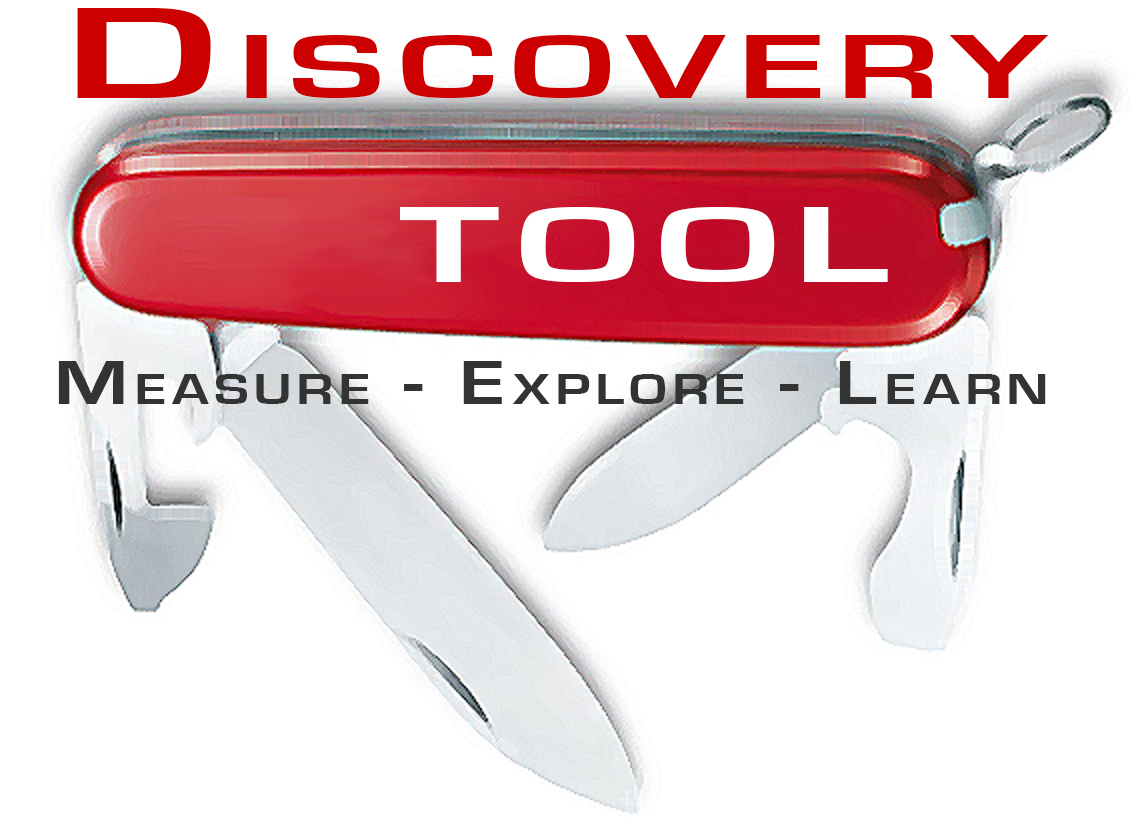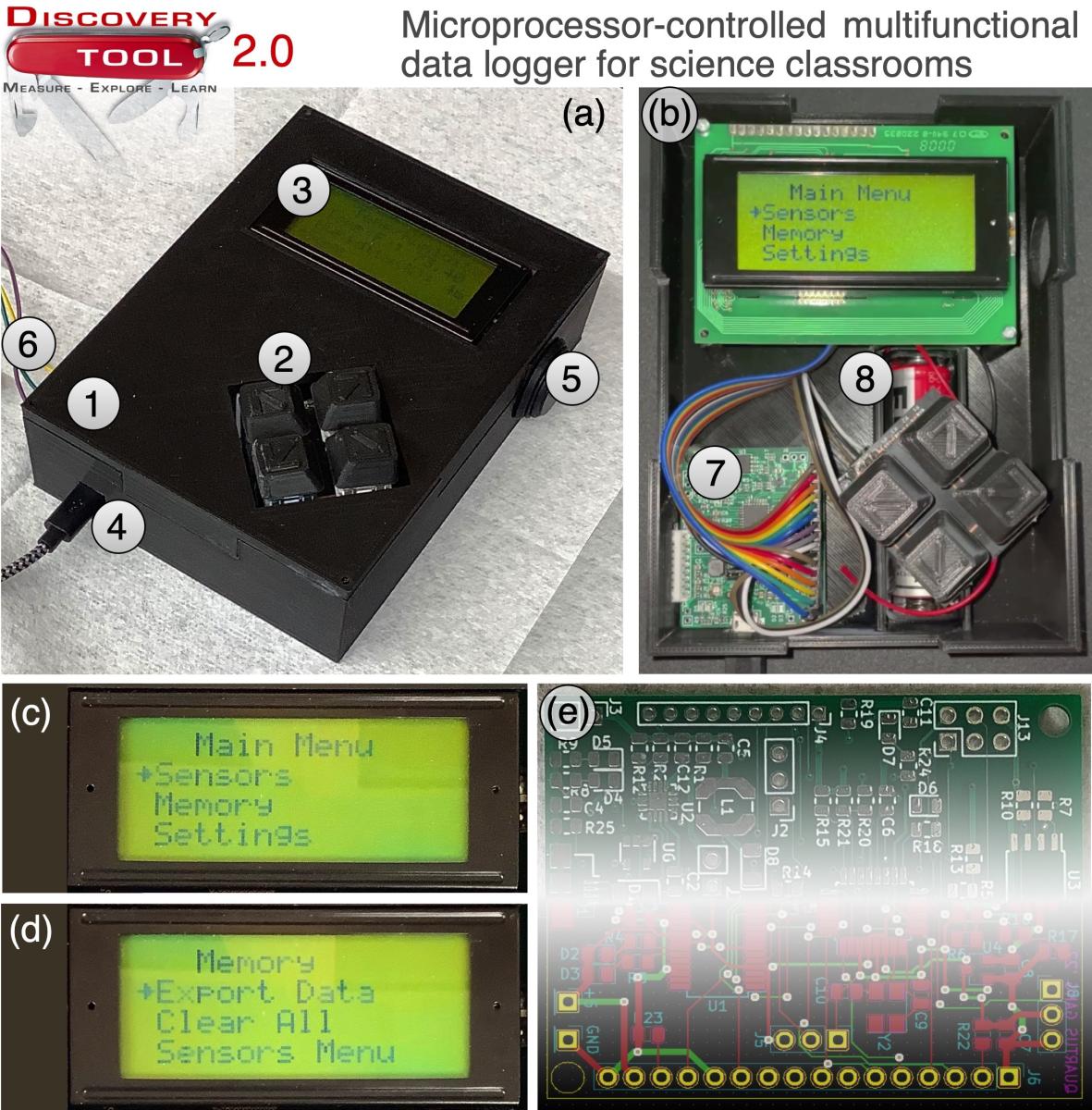
The “Swiss Army Knife” for measuring & data logging in middle/high school science classrooms (2020/21)
A Capstone Senior Design Project by Andrew Thurman, Jack Dempsey, Hunter Christensen, and Trevor Cutsor (UNL Department of Electrical & Computer Engineering, 2021), inspired and advised by Peter Sutter (with Mark Bauer).
The project described here aims at developing a multifunctional scientific measuring tool that is designed to be inexpensive and easy to use, and would therefore lend itself for middle and high school academic settings. The entire project is open-source; all information needed to build the Discovery Tool for your classroom is included in the links below. The project is sponsored by the National Science Foundation as part of the broader impact/outreach activities under Award No. DMR-1904843. The long-term goal is to develop and disseminate inexpensive learning aids for science classrooms in rural middle and high schools.
 The project provides a base platform, built around the ATMEGA328P microcontroller and capable of reading data from a number of different sensors. Following consultation with several high school science teachers, the initial suite of sensors was chosen to include: a pH meter, a voltmeter, an ultrasonic distance sensor, a beam break event sensor & timer, a digital scale, and a temperature sensor. These sensors cover a range of topics ranging from Chemistry to Physics, Earth Science and Biology. Since most of the sensors have external components that need to be wired to the microcontroller, a custom fabricated printed circuit board (PCB) was designed to internally accommodate extra circuitry for sensors as needed and to host on-board memory for data logging. The controller is battery powered for enhanced mobility, enabling use in the classroom as well as outdoors. It includes an intuitive user interface on a LCD display, navigated by a joystick. Measured data can be displayed in real time or stored in on-board EEPROM (flash) memory, to be read out via USB connection into a computer. Hence, the system operates both as a measurement platform and data logger.
The project provides a base platform, built around the ATMEGA328P microcontroller and capable of reading data from a number of different sensors. Following consultation with several high school science teachers, the initial suite of sensors was chosen to include: a pH meter, a voltmeter, an ultrasonic distance sensor, a beam break event sensor & timer, a digital scale, and a temperature sensor. These sensors cover a range of topics ranging from Chemistry to Physics, Earth Science and Biology. Since most of the sensors have external components that need to be wired to the microcontroller, a custom fabricated printed circuit board (PCB) was designed to internally accommodate extra circuitry for sensors as needed and to host on-board memory for data logging. The controller is battery powered for enhanced mobility, enabling use in the classroom as well as outdoors. It includes an intuitive user interface on a LCD display, navigated by a joystick. Measured data can be displayed in real time or stored in on-board EEPROM (flash) memory, to be read out via USB connection into a computer. Hence, the system operates both as a measurement platform and data logger.
Links provided here allow downloading ZIP files with the designs of the printed circuit board (PCB.zip), Arduino programs (Programs.zip), and 3D CAD files for the enclosure as well as the digital scale and beam-break sensors (3DPrinting.zip). Full documentation is available in a downloadable PDF file (Manual.pdf), and a set of instructional videos can be found in a Youtube channel at: https://www.youtube.com/channel/UCXzfpJAuithEzE365GipPYw.
Discovery Tool 2.0: Continued improvement of the “Swiss Army Knife” for measuring & data logging in middle/high school science classrooms(2021/22)
A Capstone Senior Design Project by Dalton Evans, Matthew Emory, Jake French, James Henry, and Samuel Probst (UNL Department of Electrical & Computer Engineering, 2021), inspired and advised by Peter Sutter (with Mark Bauer).

The continuation of the project during the 2021/22 academic year produced a complete redesign of the Discovery Tool multifunctional scientific measuring platform. While still inexpensive and easy to use, the revised device features a new look, revamped LCD based user interface with push-button navigation, expanded collection of sensing functions, as well as enhanced capabilities for saving measurements into on-board memory and transmitting data via USB connection to a computer. The Discovery Tool 2.0 can also be powered by an on-board battery for data logging in remote settings. The entire project is open-source; a description of the second generation device is provided in the students' report below, along with links to files needed to build the Discovery Tool 2.0 at your school. Why not build one in your STEM or robotics club? The project is sponsored by the National Science Foundation as part of the broader impact/outreach activities under Award No. DMR-1904843. The long-term goal is to develop and disseminate inexpensive learning aids for science classrooms in rural middle and high schools.
Documentation of the Discovery Tool 2.0: Manual. 3D Printer Code (Box, lid, buttons). Arduino Code. Circuit Board.
If you consider building a Discovery Tool or Discovery Tool 2.0, let us know. We would be happy to hear from you! For feedback, questions, or suggestions, contact Prof. Peter Sutter (psutter@unl.edu).
This material is based upon work supported by the National Science Foundation under Grant No. DMR-1904843.
Any opinions, findings, and conclusions or recommendations expressed in this material are those of the author(s) and do not necessarily reflect the views of the National Science Foundation.